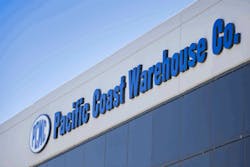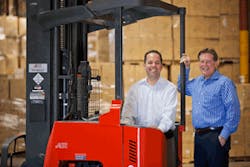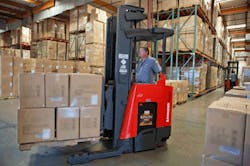Smart Use of Racks and Lift Trucks Helps One Warehouse Act like Two
Consolidating two warehouse spaces into one meant a chance for Pacific Coast Warehouse Company to gain efficiency and improve control over product and equipment. But it also meant a different warehouse design and putting a new fleet of lift trucks to work in racking that is significantly higher than in the existing locations.
Raymond Handling Solutions, with headquarters in Santa Fe Springs, Calif., helped the company devise a material handling system using deep-reach lift trucks to place loads of product on 26-foot-high racks. The change enabled Pacific Coast Warehouse to replace multiple facilities totaling 625,000 square feet with a single 412,000-square-foot warehouse in Ontario, Calif., with double-deep racking and more than 45,000 pallet positions.
“Our objective was to improve productivity and to be able to store the same number of pallets and get the same revenue in a smaller footprint, because we can cube the warehouse higher,” says Dave Boras, chief financial officer of Pacific Coast Warehouse.
Handling Overseas Business
Pacific Coast Warehouse, in business since 1927, is a third-party logistics company operating more than 1.3 million square feet of warehousing space in southern and northern California. The new facility in Ontario is part of the company’s continuous effort to improve its operation in both logistics and productivity and so reduce costs to customers.
“We had an opportunity to terminate our lease in the Chino facilities and move to a 412,000-square-foot facility in Ontario,” says Boras. “The difference was that while the old building had a 26-foot clear height, the new facility is 32 feet clear. So we had to design a whole different racking structure.”
Raymond Handling Solutions, a supplier of lift trucks and other equipment to Pacific Coast Warehouse for 26 years, was selected for the project in a competitive review process after proposing an integrated solution that included racking, lift trucks and a comprehensive lift truck service program.
“What we did was start from the beginning, helping with the design,” says Rene Lopez, senior account manager with Raymond Handling Solutions. “We determined the optimum rack height and rack spacing. We had face-to-face and phone conversations with our structural engineer. It was not just a case of selling uprights and beams.” Lopez also took Pacific Coast personnel on visits to sites where Raymond Handling Solutions had installed large deep-reach racking systems.
The Right Lift Trucks
“We saw the equipment operating in the same rack environment that we would be getting,” says Boras. “It allowed us the comfort of being able to talk to the operators there and see how they were dealing with the higher racking.”
“Raymond Handling Solutions also brought in the exact equipment we would be using for our operators to try out. That helped them get used to what they could expect when working in our new environment.”
Today 17 Raymond Model 7400 Deep-Reachelectric lift trucks work in Pacific Coast’s new facAn opportunity charging system delivers further cost savings and productivity gains. Operators charge batteries during breaks and lunch periods so that there is no need for battery changeouts for recharging at shift changes: A single battery stays with the truck through both daily work shifts. Thus instead of having to purchase two batteries per truck, Pacific Coast Warehouse purchased just one per truck, plus two for backup (a total of 19).
Work Flow
In operation at the Chino site, materials arrive from overseas in cubed-out 53-foot-long shipboard containers. A lumper service builds pallets, which are used to handle about half the loads; lift trucks using carton clamps handle the balance of product without palletized loads.
These propane-fueled sit-down lift trucks deliver loads from the receiving dock to a staging area, and from there the Reach-Fork trucks put them away in the racking. Outgoing orders are collected using Raymond Model 5400 orderpickers with fork-elevated height up to 25 feet. Those trucks deliver orders to the shipping dock, where they are loaded onto trailer by the sit-down units.
Equipment Maintenance
Helping to keep the lift trucks running is a comprehensive maintenance agreement covering maintenance and service provided by Raymond Handling Solutions.
“As CFO, I recognize that our second biggest cost other than rent is labor,” says Boras. “We have to keep our labor productive and efficient. So keeping the equipment up and running is paramount in sustaining the productive environment we need.”
As a result of this consolidation and the conversion to all-AC-drive lift trucks, Pacific Coast Warehouse achieved 20 to 25 percent higher productivity and15 to 20 percent energy savings compared with the previous operations.



